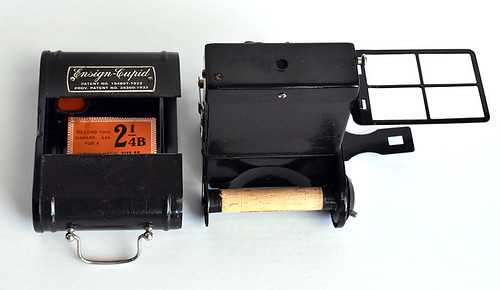Difference between revisions of "Ensign Cupid"
Hanskerensky (talk | contribs) m (Repaired Link URL) |
Hanskerensky (talk | contribs) (Added Category:120 film) |
||
| Line 33: | Line 33: | ||
* [https://www.butkus.org/chinon/ensign/ensign_cupid/ensign_cupid.htm Ensign Cupid PDF manual] at [https://www.butkus.org/chinon/index.html OrphanCameras.com] | * [https://www.butkus.org/chinon/ensign/ensign_cupid/ensign_cupid.htm Ensign Cupid PDF manual] at [https://www.butkus.org/chinon/index.html OrphanCameras.com] | ||
| − | [[Category: C|Cupid]] | + | [[Category: C|Cupid Ensign]] |
[[Category: Ensign|Cupid]] | [[Category: Ensign|Cupid]] | ||
| + | [[Category:120 film]] | ||
Revision as of 06:21, 9 January 2023

|
| (1922) Houghton Ensign Cupid image by KEH Camera (Image rights) |
The Ensign Cupid is a small sheet-metal bodied camera made by British manufacturer Houghton-Butcher under their Ensign brand, c.1922. The viewfinder is a simple folding frame. The camera uses dual red windows to shoot in 2-1/4" x 1-1/2" format, giving "twelve pictures for the price of six."[1] The shutter is cocked by lifting the button in front of the viewfinder and fired with the button below the T I selector. The camera was relatively cheap, at 18s-6d.
The camera uses several patents, including British Patent 13246 (W.H. Harvey, 1914) - for using two red windows for doubling the number of (half-sized) exposures on a film roll, by using each number twice; this is possibly the first camera to use this arrangement. Later models are marked with BP 207637, covering the shutter design. 1922 Patents 194897 and 24360 are also marked.
There were three finishes produced, crackle black (the most common), smooth black (on early examples) and dark blue. An accessory brilliant finder was available.

|
| image by Geoff Harrisson (Image rights) |